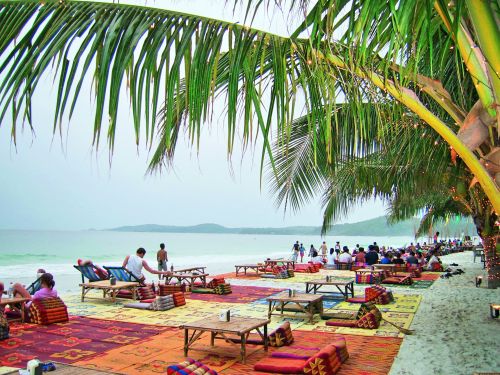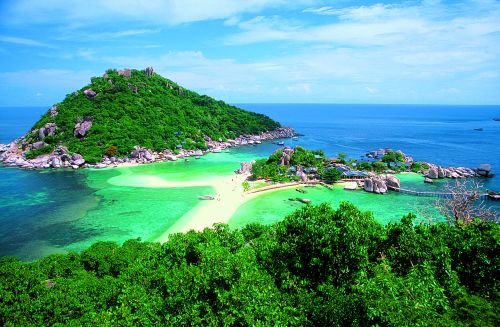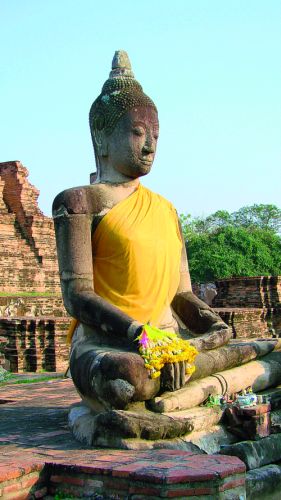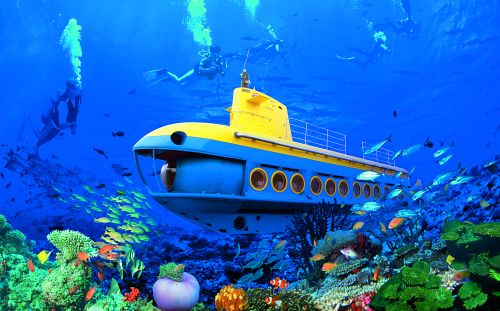 Thailand Thailand
The Kingdom of Thailand is an independent country that lies in the heart of Southeast Asia.It is bordered to the north by Laos and Myanmar, to the east by Laos and Cambodia, to the south by the Gulf of Thailand and Malaysia, and to the west by the Andaman Sea and Myanmar. Its maritime boundaries include Vietnam in the Gulf of Thailand to the southeast and Indonesia and India in the Andaman Sea to the southwest. The capital and largest city of Thailand is Bangkok. It is also the country's center of political, commercial, industrial and cultural activities.Thailand is the world's 50th largest country in terms of total area (slightly smaller than Yemen and slightly larger than Spain), with a surface area of approximately 513,000 km2 (198,000 sq mi), and the 21st most-populous country, with approximately 64 million people. About 75% of the population is ethnically Thai, 14% is of Chinese origin, and 3% is ethnically Malay;the rest belong to minority groups including Mons, Khmers and various hill tribes. There are approximately 2.2 million legal and illegal migrants in Thailand.Thailand has also attracted a small number of expatriates from developed countries.The country's official language is Thai.Thailand is one of the most devoutly Buddhist countries in the world. The national religion is Theravada Buddhism which is practiced by more than 94.7% of all Thais. Muslims make up 4.6% of the population and 0.7% belong to other religions.[8] Culture and traditions in Thailand are significantly influenced by India, as are Burma, Laos and Cambodia.Thailand is a constitutional monarchy with King Bhumibol Adulyadej, the ninth king of the House of Chakri, as the ruling monarch. The king has reigned for more than sixty-three years, making him the longest reigning Thai monarch and the longest reigning current monarch in the world. The king is officially titled as the Head of State, the Head of the Armed Forces, an Upholder of the Buddhist religion, and the Defender of all faiths.Thailand experienced rapid economic growth between 1985 and 1995 and today is a newly industrialized country with an emphasis on exports and a flourishing tourism industry, thanks to various world-famous tourist destinations such as Pattaya, Bangkok, and Phuket.
 Etymology Etymology
The Country's official name was Siam until June 23, 1939,when it was changed to Thailand.It was renamed Siam from 1945 to May 11, 1949, after which it was again renamed Thailand. Also spelled Siem, Syam or Syama, it has been identified with the Sanskrit Syama. The names Shan and A-hom seem to be variants of the same word, and Syama is possibly not its origin but a learned and artificial distortion.The word Thai (???) is not, as commonly believed, derived from the word Tai meaning "freedom" in the Thai language; it is, however, the name of an ethnic group from the central plains (the Thai people).A famous Thai scholar argued that Tai simply means "people" or "human being" since his investigation shows that in some rural areas the word "Tai" was used instead of the usual Thai word "khon" (??) for people.The phrase "Land of the free" is derived from Thai pride in the fact that Thailand is the only country in Southeast Asia never colonized by a European power.The Thai National Anthem refers to the Thai nation as: prathet-thai.The first line of the national anthem is: prathet thai ruam lueat neua chat chuea thai and was translated in 1939 by Colonel Luang Saranuprabhandi as: “Thailand is the unity of Thai blood and body.”While the Thai people will often refer to their country using the polite form prathet-thai they most commonly use the more colloquial word 'Mueang-Thai'or simply Thai the word mueang meaning nation but most commonly used to refer to a city or town.Ratcha Anachak Thai means "Kingdom of Thailand"or "Kingdom of Thai".Etymologically, its components are: -Ratcha-raja,-ana-chak.
History
The region known as Thailand has been inhabited by humans since the Paleolithic period, about 10,000 years ago. Before the fall of the Khmer Empire in the 13th century, various states thrived there, such as the various Tai, Mon, Khmer and Malay kingdoms, as seen through the numerous archaeological sites and artifacts that are scattered throughout the Siamese landscape. Prior to the 12th century however, the first Thai or Siamese state is traditionally considered to be the Buddhist kingdom of Sukhothai, which was founded in 1238.
Following the decline and fall of the Khmer empire in the 13th–14th century, the Buddhist Tai kingdoms of Sukhothai, Lanna and Lan Chang were on the ascension. However, a century later, Sukhothai's power was overshadowed by the new kingdom of Ayutthaya, established in the mid-14th century in the lower Chao Phraya River, or Menam area. Ayutthaya's expansion centered along the Menam while in the northern valley Lanna Kingdom and other small Tai city-states ruled the area.Thailand retained a tradition of trade with its neighboring states, from China to India, Persia and Arab lands. Ayutthaya became one of the most vibrant trade centers in Asia. European traders arrived in the 16th century, beginning with the Portuguese, followed by the French, Dutch and English.After the fall of the Ayutthaya in 1767 to the Burmese, King Taksin the Great moved the capital of Thailand to Thonburi for approximately 15 years. The current Rattanakosin era of Thai history began in 1782, following the establishment of Bangkok as capital of the Chakri dynasty under King Rama I the Great. A quarter to a third of the population of some areas of Thailand were slaves.Despite European pressure, Thailand is the only Southeast Asian nation that has never been colonized. Two main reasons for this were that Thailand had a long succession of very able rulers in the 19th century, and that it was able to exploit the rivalry and tension between the French and the British. As a result, the country remained a buffer state between parts of Southeast Asia that were colonized by the two colonial powers.
 Despite this, Western influence led to many reforms in the 19th century and major concessions, most notably being the loss of a large territory on the east side of the Mekong to the French and the step-by-step absorption by Britain of the Shan (Thai Yai) States (now in Burma)and the Malay Peninsula. The losses initially included Penang and Tumasik and eventually culminated in the loss of four predominantly ethnic-Malay southern provinces, which later became Malaysia's four northern states, under the Anglo-Siamese Treaty of 1909.In 1932, a bloodless revolution carried out by a small group of military and civilian officials resulted in a transition of power, when King Prajadhipok was forced to grant the people of Siam their first constitution, thereby ending centuries of absolutist monarchy.During World War II, the Empire of Japan demanded the right to move troops across Thailand to the Malayan frontier. Japan invaded the country and engaged the Thai army for six to eight hours before Plaek Pibulsonggram ordered an armistice. Shortly thereafter Japan was granted free passage, and on December 21, 1941, Thailand and Japan signed a military alliance with a secret protocol wherein Tokyo agreed to help Thailand regain territories lost to the British and French. Subsequently, Thailand undertook. Despite this, Western influence led to many reforms in the 19th century and major concessions, most notably being the loss of a large territory on the east side of the Mekong to the French and the step-by-step absorption by Britain of the Shan (Thai Yai) States (now in Burma)and the Malay Peninsula. The losses initially included Penang and Tumasik and eventually culminated in the loss of four predominantly ethnic-Malay southern provinces, which later became Malaysia's four northern states, under the Anglo-Siamese Treaty of 1909.In 1932, a bloodless revolution carried out by a small group of military and civilian officials resulted in a transition of power, when King Prajadhipok was forced to grant the people of Siam their first constitution, thereby ending centuries of absolutist monarchy.During World War II, the Empire of Japan demanded the right to move troops across Thailand to the Malayan frontier. Japan invaded the country and engaged the Thai army for six to eight hours before Plaek Pibulsonggram ordered an armistice. Shortly thereafter Japan was granted free passage, and on December 21, 1941, Thailand and Japan signed a military alliance with a secret protocol wherein Tokyo agreed to help Thailand regain territories lost to the British and French. Subsequently, Thailand undertook.
Administrative divisions
Thailand is divided into 75 provinces, which are gathered into 5 groups of provinces by location. There are also 2 special governed districts: the capital Bangkok (Krung Thep Maha Nakhon) and Pattaya, of which Bangkok is at provincial level and thus often counted as a 76th province.Each province is divided into districts and the districts are further divided into sub-districts (tambons).As of 2006 there are 877 districts and the 50 districts of Bangkok. Some parts of the provinces bordering Bangkok are also referred to as Greater Bangkok. These provinces include Nonthaburi, Pathum Thani, Samut Prakan, Nakhon Pathom and Samut Sakhon. The name of each province's capital city is the same as that of the province. For example, the capital of Chiang Mai province (changwat Chiang Mai)is Mueang Chiang Mai or Chiang Mai. The 76 provinces are as follows
Central
Ang Thong,Bangkok (Krung Thep Maha Nakhon), Special Governed District of,Chai Nat,Kanchanaburi,Lopburi,Nakhon,Nayok,NakhonPathom,Nonthaburi,Pathum Thani,Phetchaburi,Phra Nakhon Si Ayutthaya,Prachuap Khiri Khan,Ratchaburi Samut,Prakan Samut Sakhon,Samut,Songkhram Saraburi,Sing Buri,Suphan Buri.
East
Chachoengsao,Chanthaburi,Chonburi,Prachinburi,Rayong,Sa Kaeo,Trat.
North
Chiang Mai,Chiang Rai,Kamphaeng,Phet,Lampang,Lamphun,Mae Hong,Son,Nakhon,Sawan,Nan,Phayao,Phetchabun,Phichit,Phitsanulok,Phrae, Sukhothai,Tak,Uthai Thani,Uttaradit.
Northeast (Isan)
Amnat Charoen,Buri Ram,Chaiyaphum,Kalasin,Khon Kaen,Loei,Maha Sarakham,Mukdahan,Nakhon Phanom,Nakhon Ratchasima,Nong Bua Lamphu
Nong Khai,Roi Et,Sakon Nakhon,Si Sa Ket,Surin,Ubon Ratchathani,Yasothon.
South
Chumphon,Krabi,Nakhon Si Thammarat,Narathiwat,Pattani,Phang Nga,Phatthalung,Phuket,Ranong,Satun,Songkhla,Surat Thani,Trang,Yala.
History:Totaling 513,120 square kilometres (198,120 sq mi),Thailand is the world's 50th largest country in land mass, while it is the world's 20th largest country in terms of population. It is comparable in population to countries such as France and the United Kingdom, and is similar in land size to France and California in the United States; it is just over twice the size of the entire United Kingdom, and 1.4 times the size of Germany. The local climate is tropical and characterized by monsoons. There is a rainy, warm, and cloudy southwest monsoon from mid-May to September, as well as a dry, cool northeast monsoon from November to mid-March. The southern isthmus is always hot and humid.Thailand is home to several distinct geographic regions, partly corresponding to the provincial groups. The north of the country is mountainous, with the highest point being Doi Inthanon at 2,565 metres above sea level (8,415 ft). The northeast, Isan, consists of the Khorat Plateau, bordered to the east by the Mekong River. The centre of the country is dominated by the predominantly flat Chao Phraya river valley, which runs into the Gulf of Thailand. The south consists of the narrow Kra Isthmus that widens into the Malay Peninsula. Politically, there are six geographical regions which differ from the others in population, basic resources, natural features, and level of social and economic development. The diversity of the regions is the most pronounced attribute of Thailand's physical setting.The Chao Phraya and the Mekong River are the sustainable resource of rural Thailand. Industrial scale production of crops use both rivers and their tributaries. The Gulf of Thailand covers 320,000 km and is fed by the Chao Phraya, Mae Klong, Bang Pakong and Tapi Rivers. It contributes to the tourism sector owing to its clear shallow waters along the coasts in the Southern Region and the Kra Isthmus. The Gulf of Thailand is also an industrial center of Thailand with the kingdom's main port in Sattahip along with being the entry gates for Bangkok's Inland Seaport. The Andaman Sea is regarded as Thailand's most precious natural resource as it hosts the most popular and luxurious resorts in Asia. Phuket, Krabi, Ranong, Phang Nga and Trang and their lush islands all lay along the coasts of the Andaman Sea and despite the 2004 Tsunami, they continue to be and ever more so, the playground of the rich and elite of Asia and the world.Plans have resurfaced of a logistical connection of the two bodies of water which would be coined the Thai Canal, analogous to the Suez and the Panama Canal. Such an idea has been greeted with positive accounts by Thai politicians as it would cut fees charged by the Ports of Singapore, improve ties with China and India, lower shipping times and increase ship safety owing to pirate fears in the Strait of Melaka and, support the Thai government's policy of being the logistical hub for Southeast Asia. The ports would improve economic conditions in the south of Thailand, which relies heavily on tourism income, and it would also change the structure of the Thai economy moving it closer to a services center of Asia. The canal would be a major engineering project and has expected costs of 20–30 billion dollars.
Demographics
Language
The official language of Thailand is the Thai language, a Kradai language closely related to Lao, Shan in Burma, and numerous smaller languages spoken in an arc from Hainan and Yunnan south to the Malaysian border. It is the principal language of education and government and spoken throughout the country. The standard is based on the dialect of the central Thai people, and it is written in the Thai alphabet, an abugida script that evolved from the Khmer script. Several other dialects exist, and coincide with the regional designations. Southern Thai is spoken in the southern provinces, and Northern Thai is spoken in the provinces that were formally part of the independent kingdom of Lannathai.Thailand is also host to several other minority languages, the largest of which is the Lao dialect of Isan spoken in the northeastern provinces. Although sometimes considered a Thai dialect, it is a Lao dialect, and the region in where it is traditionally spoken was historically part of the Lao kingdom of Lan Xang. In the far south, Yawi, a dialect of Malay, is the primary language of the Malay Muslims. Chinese dialects are also spoken by the large Chinese population, Teochew being the dialect best represented.Numerous tribal languages are also spoken, including those belonging to the Mon-Khmer family, such as Mon, Khmer, Viet, Mlabri;Austronesian family, such as Cham, Moken, and Orang Asli, Sino-Tibetan family such as Lawa, Akhan, and Karen; and other Tai languages such as Nyaw, Phu Thai, and Saek. Hmong is a member of the Hmong-Mien languages, which is now regarded as a language family of its own.English is a mandatory school subject, but the number of fluent speakers remains very low, especially outside the cities.
 Religion Religion
According to the last census (2000) 94.7% of the total population are Buddhists of the Theravada tradition. Muslims are the second largest religious group in Thailand at 4.6%.Thailand's southernmost provinces – Pattani, Yala, Narathiwat and part of Songkhla Chumphon have dominant Muslim populations, consisting of both ethnic Thai and Malay. The southern tip of Thailand is mostly ethnically Malay, and most Malays are Sunni Muslims. Christians represent 0.5% of the population. A tiny but influential community of Sikhs in Thailand and some Hindus also live in the country's cities, and are heavily engaged in retail commerce. There is also a small Jewish community in Thailand, dating back to the 17th century. Since 2001, Muslim activists have rallied against the central government because of alleged corruption and ethnic bias among officials.
Culture
The culture of Thailand incorporates a great deal of influence from India, China, Cambodia, and the rest of Southeast Asia. Thailand's  national religion Theravada Buddhism is central to modern Thai identity and belief. In practice, Thai Buddhism has evolved over time to include many regional beliefs originating from Hinduism, animism as well as ancestor worship. In areas in the southernmost parts of Thailand, Islam is prevalent. Several different ethnic groups, many of which are marginalized, populate Thailand. Some of these groups overlap into Burma, Laos, Cambodia, and Malaysia and have mediated change between their traditional local culture, national Thai and global cultural influences. Overseas Chinese also form a significant part of Thai society, particularly in and around Bangkok. Their successful integration into Thai society has allowed for this group to hold positions of economic and political power. After World War II, American missionaries sought to win Christian converts in Thailand. Harold Reeves, for instance, in 1952 became the first missionary to Thailand sent by the Southern Baptist Convention national religion Theravada Buddhism is central to modern Thai identity and belief. In practice, Thai Buddhism has evolved over time to include many regional beliefs originating from Hinduism, animism as well as ancestor worship. In areas in the southernmost parts of Thailand, Islam is prevalent. Several different ethnic groups, many of which are marginalized, populate Thailand. Some of these groups overlap into Burma, Laos, Cambodia, and Malaysia and have mediated change between their traditional local culture, national Thai and global cultural influences. Overseas Chinese also form a significant part of Thai society, particularly in and around Bangkok. Their successful integration into Thai society has allowed for this group to hold positions of economic and political power. After World War II, American missionaries sought to win Christian converts in Thailand. Harold Reeves, for instance, in 1952 became the first missionary to Thailand sent by the Southern Baptist Convention
Like most Asian cultures, respect towards ancestors is an essential part of Thai spiritual practice. Thais have a strong sense of hospitality and generosity, but also a strong sense of social hierarchy. Seniority is an important concept in Thai culture. Elders have by tradition ruled in family decisions or ceremonies. Older siblings have duties to younger ones.
The traditional Thai greeting, the wai, is generally offered first by the younger of the two people meeting, with their hands pressed together, fingertips pointing upwards as the head is bowed to touch their face to the hands, usually coinciding with the spoken word "Sawasdee khrap" for male speakers, and "Sawasdee ka" for females. The elder then is to respond afterwards in the same way. Social status and position, such as in government, will also have an influence on who performs the wai first. For example, although one may be considerably older than a provincial governor, when meeting it is usually the visitor who pays respect first. When children leave to go to school, they are taught to wai to their parents to represent their respect for them. They do the same when they come back. The wai is a sign of respect and reverence for another, similar to the namaste greeting of India and Nepal.Muay Thai, or Thai boxing, is the national sport in Thailand and its native martial art call "Muay". In the past "Muay" was taught to royal soldiers for combat on battlefield if unarmed. After they retired from the army, these soldiers often became Buddhist monks and stayed at the temples. Most of the Thai people's lives are closely tied to Buddhism and temples; they often send their sons to be educated with the monks. ”Muay” is also one of the subjects taught in the temples.Muay Thai achieved popularity all over the world in the 1990s. The feature film Fight or Flight, which won "Best Foreign Documentary" at the Long Island Film Festival, documented a westerners journey in the Muay Thai circuit in Thailand Fight or Flight official movie website. Although similar martial arts styles exist in other southeast Asian countries, few enjoy the recognition that Muay Thai has received with its full-contact rules allowing strikes including elbows, throws and knees. This is due to Thailand's economic standing in the world while other nation such as Cambodia, Laos and Burma are listed as the world's Least Developed Countries by the UN. Association football, however, has possibly overtaken Muay Thai's position as most widely viewed and liked sport in contemporary Thai society and it is not uncommon to see Thais cheering their favourite English Premier League teams on television and walking around in replica kits. Another widely enjoyed pastime, and once a competitive sport, is kite flying.
Taboos in Thailand include touching someone's head or pointing with the feet, as the head is considered the most sacred and the foot the dirtiest part of the body. Stepping over someone, or over food, is considered insulting. However, some traditional taboos in Thai culture, as in many other Asian cultures, have lost their meaning and are less of an integrating force in a globalized Thai culture.Books and other documents are the most revered of secular objects. One should not slide a book across a table or place it on the floor.Some common ingredients used in Thai cuisine include garlic, chillies, lime juice, lemon grass, and fish sauce. The staple food in Thailand is rice, particularly particularly jasmine variety rice (also known as Hom Mali rice) which is included in almost every meal. Thailand is the world's largest exporter of rice, and Thais domestically consume over 100 kg of milled rice per person per year.Over 5000 varieties of rice from Thailand are preserved in the rice gene bank of the International Rice Research Institute (IRRI), based in the Philippines. The king of Thailand is the official patron of IRRI. Thai society has been influenced in recent years by its widely available multi-language press and media. There are numerous English, Thai and Chinese newspapers in circulation; most Thai popular magazines use English headlines as a chic glamor factor. Most large businesses in Bangkok operate in English as well as other languages. Thailand is the largest newspaper market in Southeast Asia with an estimated circulation of at least 13 million copies daily in 2003. Even upcountry, out of Bangkok, media flourishes. For example, according to Thailand's Public Relations Department Media Directory 2003-2004, the nineteen provinces of northeast Thailand themselves hosted 116 newspapers along with radio, TV and cable.
|















